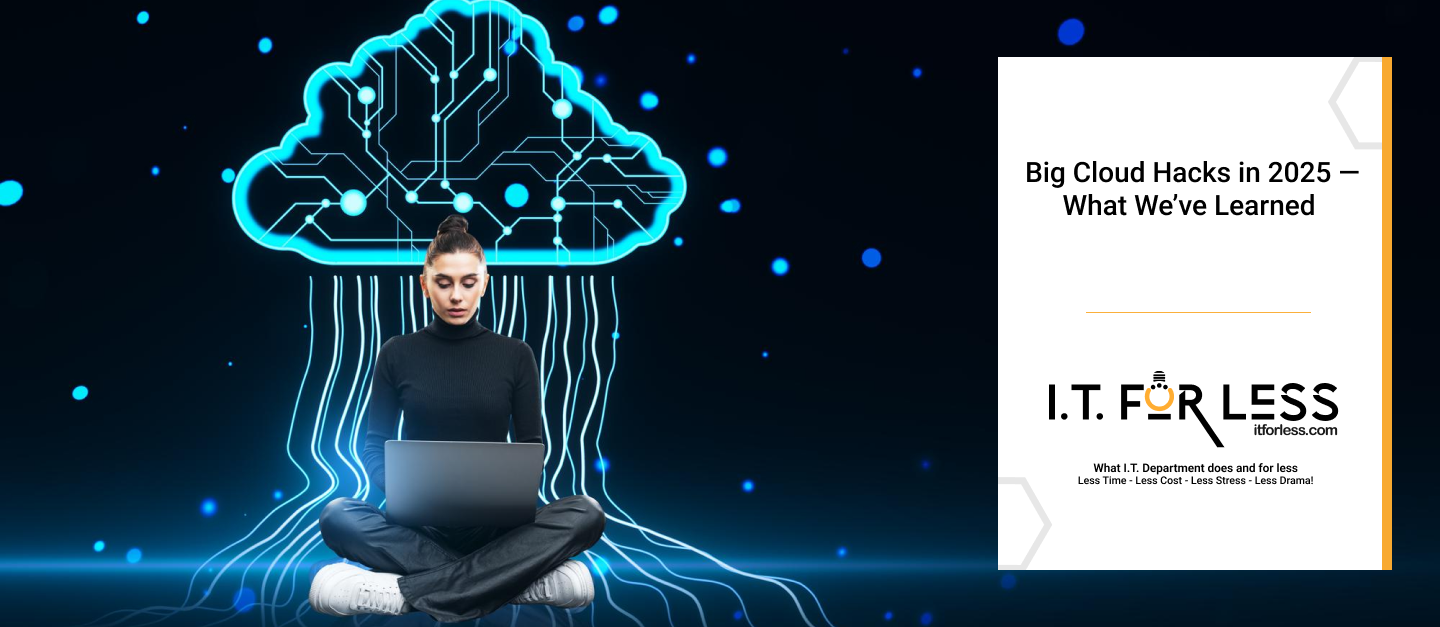In 2025, the cloud was a battlefield.
From government agencies to global retailers and healthcare platforms, some of the world’s most prominent organizations were hit with devastating cloud-based cyberattacks. As an MSP dedicated to protecting businesses of all sizes, I.T. For Less closely monitors these incidents, not just to stay informed, but to understand what went wrong and how our clients can stay protected.
This article explores some of the biggest cloud hacks in 2025, the mistakes that made them possible, and the security lessons every business — big or small — can take away.
1. The MedVault Healthcare Breach
Industry: Healthcare
Data Affected: Over 18 million patient records
Attack Type: Ransomware-as-a-Service (RaaS) via misconfigured cloud storage
What Happened: Hackers gained access to MedVault’s cloud storage by exploiting a publicly exposed S3 bucket that was never properly secured. Once inside, attackers deployed a ransomware payload and encrypted the majority of the data.
The Mistake: Misconfigured cloud resources and no automated vulnerability scanning.
Lesson Learned:
- Always audit your storage configurations.
- Implement continuous cloud security posture management (CSPM).
- Enforce strict access controls and encryption policies.
2. RetailX Credential Stuffing Attack
Industry: E-commerce
Data Affected: 4 million customer credentials
Attack Type: Credential stuffing using AI-generated attack patterns
What Happened: RetailX, a fast-growing online store, fell victim to a massive credential stuffing campaign. Attackers used AI to mimic human behavior, allowing them to bypass basic rate limits and CAPTCHA protections.
The Mistake: Weak MFA implementation and lack of AI-based threat detection.
Lesson Learned:
- Deploy adaptive MFA and block login attempts based on behavioral analytics.
- Use AI to combat AI. Automated monitoring is essential in today’s landscape.
- Monitor failed login patterns in real time.
3. EduCloud University Leak
Industry: Education
Data Affected: 2.3 million student and faculty records
Attack Type: Insider threat with misused access
What Happened: A disgruntled former employee of EduCloud University still had access to cloud accounts weeks after leaving. They extracted sensitive data and posted it on a public forum.
The Mistake: Poor offboarding process and failure to rotate access credentials.
Lesson Learned:
- Enforce zero-trust principles and least privilege access.
- Automated deprovisioning of users during offboarding.
- Conduct regular access audits.
4. FinTechPro API Exploit
Industry: Financial Services
Data Affected: Financial transaction data of 7 million users
Attack Type: API vulnerability exploitation
What Happened: Hackers discovered a flaw in an exposed API used by FinTech Pro’s mobile app. With minimal effort, they bypassed authentication and accessed personal financial data.
The Mistake: Lack of API gateway security and insufficient testing.
Lesson Learned:
- Secure all APIs using AI-powered API protection.
- Apply strict authentication and authorization to all endpoints.
- Conduct regular penetration testing on all public interfaces.
5. GovCloud DDoS Disruption
Industry: Public Sector
Data Affected: None stolen, but 12 government services taken offline
Attack Type: Distributed Denial of Service (DDoS)
What Happened: An activist hacking group launched a coordinated DDoS attack on several cloud-hosted government applications, using botnets powered by compromised IoT devices. The attack lasted 36 hours.
The Mistake: No auto-scaling or DDoS mitigation strategy in place.
Lesson Learned:
- Enable cloud-native DDoS protection (like AWS Shield or Azure DDoS Protection).
- Use scalable architectures that absorb surges.
- Monitor for unusual traffic spikes.
What These Attacks Have in Common
Despite the variety in industries and attack vectors, several patterns stand out:
- Human error and misconfiguration are still the top causes of cloud breaches.
- AI-powered attacks are on the rise, and businesses must fight fire with fire.
- Zero Trust, encryption, access controls, and monitoring are no longer optional.
How I.T. For Less Helps You Stay Safe
At I.T. For Less, we believe cloud security should be:
- Affordable: Enterprise-grade tools tailored to small business budgets.
- Easy: Simple, guided implementation.
- Proactive: Real-time monitoring, threat detection, and rapid response.
We help our clients:
- Set up cloud environments with minimal risk
- Monitor and respond to threats 24/7
- Stay compliant with HIPAA, PCI, GDPR, and more
- Use AI and automation to stay ahead of evolving cyberattacks
Final Thoughts
The cloud isn’t going away — and neither are hackers. But with the right practices, partners, and tools, you can keep your business protected.
2025 reminded us that even the biggest companies can make the smallest mistakes. You don’t have to what?
Let I.T. For Less guide you through a smarter, safer cloud journey.
Need help auditing your current cloud setup or upgrading your security?
